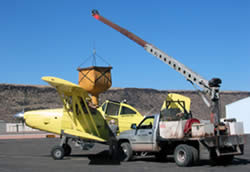
National Fire Plan Success Story
2006 Emergency Stabilization in Color Country BLM

Seed being loaded into planes by contractors for aerial broadcast.
Thousands of acres were blackened during 2006 summer wildfires. In the aftermath, the Cedar City Fuels program implemented emergency stabilization and post-fire rehabilitation plans for public lands in Beaver, Iron, Garfield, Kane and Washington counties.
This year, approximately 171,000 acres were treated during emergency stabilization and post-fire rehabilitation work. Emergency stabilization and post-fire rehabilitation work improves public lands that are unlikely to recover naturally from the effects of wildfires. Emergency stabilization treatments are essential to protecting the lives and properties surrounding burned areas.
This work, often implemented over the course of several years following a wildfire, includes invasive plant treatments, replanting and reseeding with native or other desirable vegetation, road and trail rehabilitation, fence replacement, wildlife habitat restoration and reforestation. Emergency stabilization and post-fire rehabilitation is done to support the goals set forth by the National Fire Plan.
One of the first steps in emergency stabilization is the replanting and reseeding of blackened areas. The Cedar City Fuels Program had an all-time record year in both the amount and variety of seed purchased. This year, over 20 species totaling 880,000 pounds of seed were purchased, during two seed buying trips. Seed was delivered from locations around the country over a two-week period, in October and then again in December. After delivery, our fuels and fire crews worked along side contractors to get the seed mixed and ready for application. In October, the seed mixing was completed in six days, with approximately 50,000 pounds mixed each day.
Aerial broadcast of seed on 136,000 acres took place over several weeks and was accomplished before the first significant winter storm. Over 35,000 acres were chained in order to ensure seed was covered and to minimize loss from weather and wildlife. Due to the amount of rangeland managed by the Cedar City Field Office, replanting and reseeding of burnt areas is our main focus during stabilization.
Though stabilization efforts are winding down, rehabilitation measures are in place and ready to be implemented this spring. We hope to have green lands again this spring.
Contact: Brent Spackman at 435-865-3029.